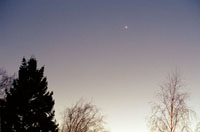
Image taken with Pentax MX on a tripod with 50mm lens, 1:2,8
5sec on Fuji Superia 200
Sibylle Fröhlich
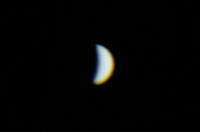
Image taken with 114/900mm Newtonian and 6mm eyepiece
resulting focal length 10m, 1:90, 1/2 sec on Fuji Superia 200.
The image is showing venus about 4 weeks after it's maximum westward elongation,
which was January 17th, 2001 6:00 UT
The illuminated fraction of the disc was 37%
Sibylle Fröhlich
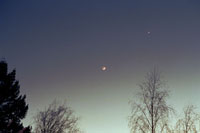
Image taken with Pentax MX on a tripod with 50mm lens, 1:2,8
3sec on Fuji Superia 200
Sibylle Fröhlich
Moonphase 3d 9h 6'
Sibylle Fröhlich
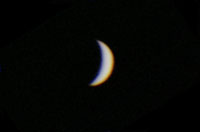
Image taken with 114/900mm Newtonian and 6mm eyepiece
resulting focal length 10m, 1:90, 1/2 sec on Fuji Superia 200.
The image is showing venus 9days after it's maximum magnitude which was
February 22nd, 2001, 1:00 UT
The illuminated fraction of the disc was 20%
Sibylle Fröhlich
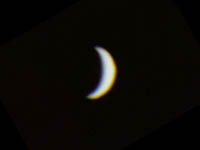
Image taken with 114/900mm Newtonian and 6mm eyepiece
resulting focal length 10m, 1:90, 1/4 sec on Kodak Klassik 200.
The illuminated fraction of the disc was 16 %
Sibylle Fröhlich


The illuminated fraction of the disc was 12%
Gert Gottschalk
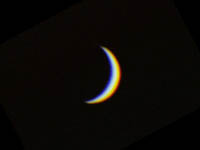
Image taken with 114/900mm Newtonian and 6mm eyepiece
resulting focal length 10m, 1:90, 1/4 sec on Kodak Klassik 200.
The illuminated fraction of the disc was 7,9 %
Sibylle Fröhlich


Same camera and exposure settings as march 3rd, 2001.
The illuminated fraction of the disc was 6%
Gert Gottschalk

Camera settings same as on March 3rd, 2001
Telescope was a 80mm MC ED Apo refractor focal length 640mm, 1:8. with 9mm eyepiece and 2.5x Barlow lens
The illuminated fraction of the disc was 2%
Gert Gottschalk
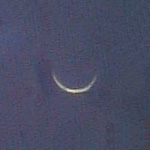
Same camera and exposure settings as on March 24th, 2001
The illuminated fraction of the disc was 1%, distance from sun 8degree !
Gert Gottschalk